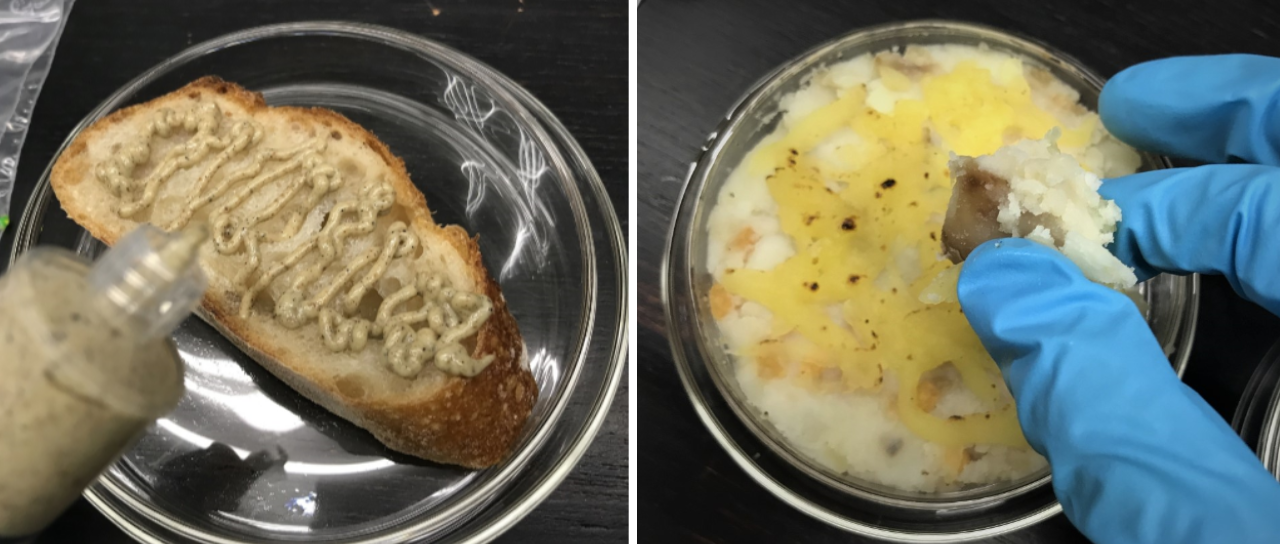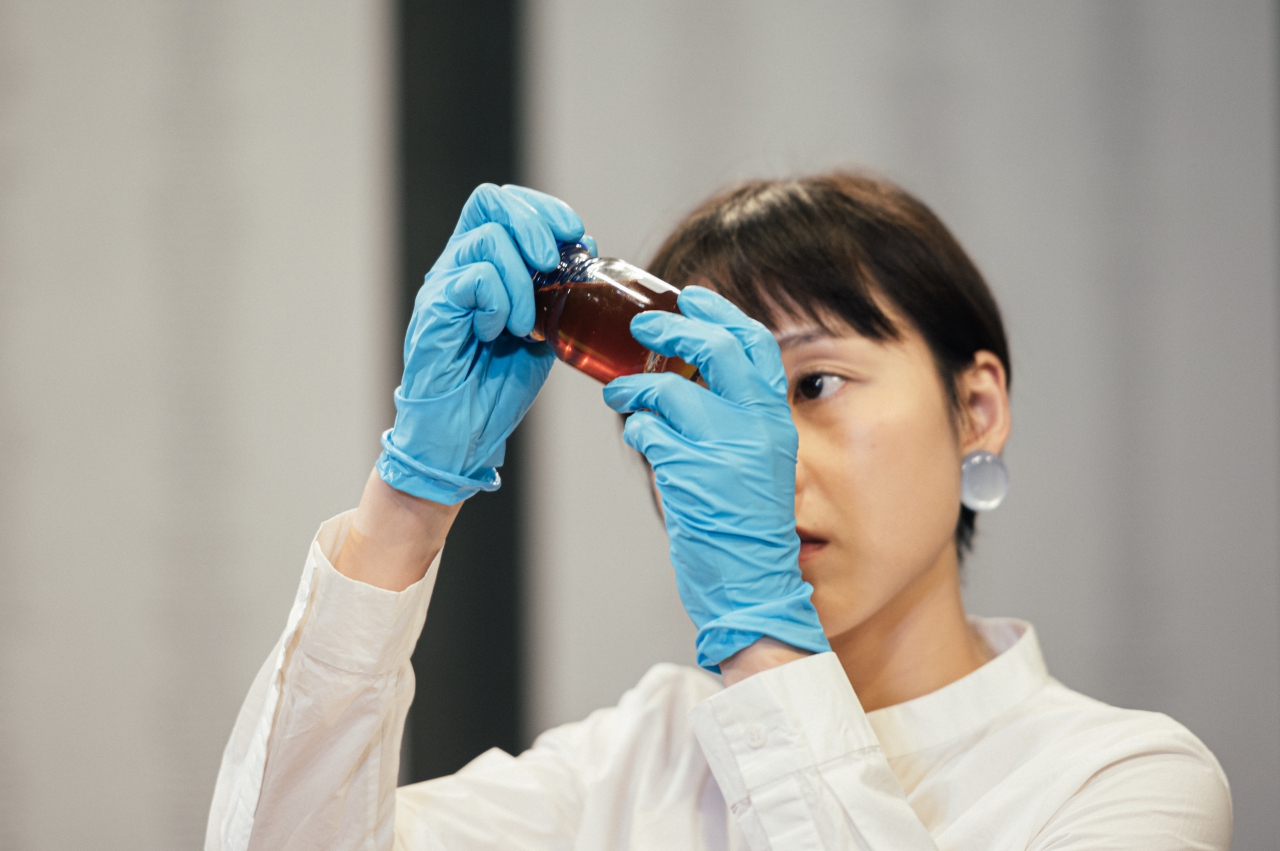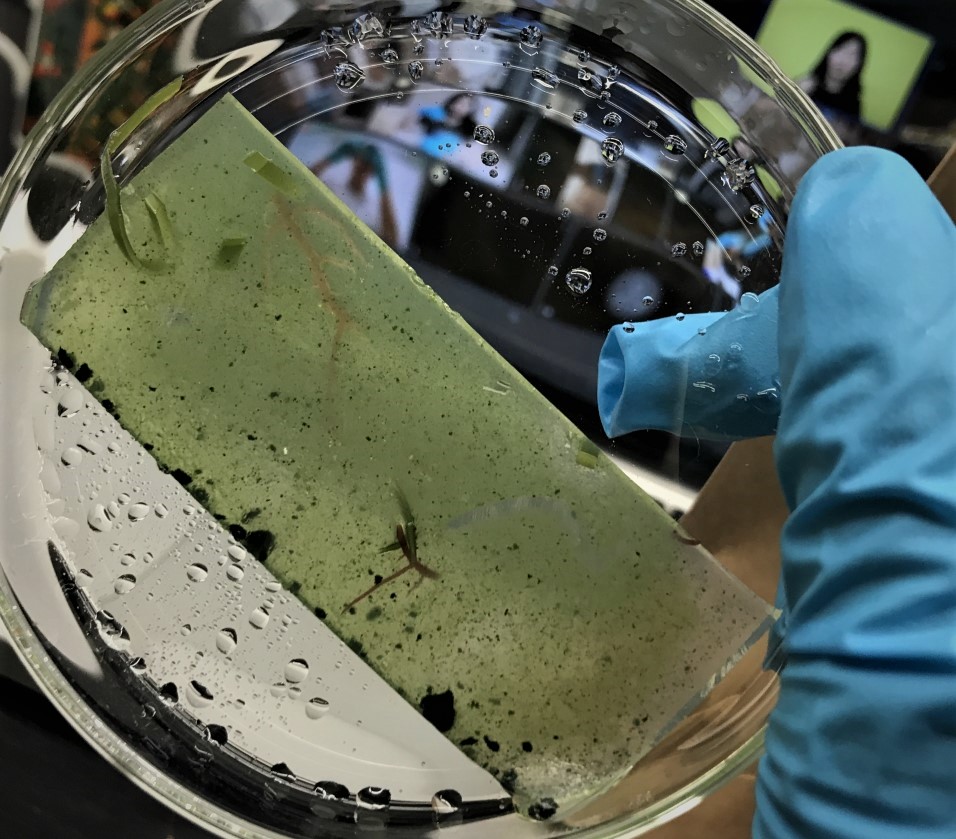2020年,當嚴重特殊傳染性肺炎(COVID-19,武漢肺炎)對全球造成幾乎無可逆轉的改變,因個人行程滯於荷蘭的藝術家林沛瑩受空總臺灣當代文化實驗場(C-LAB)的委託,在6月20及21日舉辦了兩個場次、每次僅15人參與的《病毒之愛》晚餐表演隔離版。即便疫情在臺灣已稍稍趨緩,卻又稱不上可以完全解除警戒,原先應該同桌共食、病菌交歡的參與者,被迫於美好的星期五晚上在家自我隔離,透過主辦單位建立的通訊軟體群組保持通訊暢通,靜待外送員帶來的餐點,並在約定的時間進入線上的直播室赴約。
一如當今越來越多跨領域地涉獵不同知識以進行創作的藝術家,林沛瑩的專業背景也相當多元,單就有學歷認證的專業背景就橫跨了生命科學、資訊工程、社會科學-文化研究以及設計研究。因而我們並不難在她長期發展的幾組作品中,發現遊走在科學知識和人類社會之間的創作途徑,這種「之間」的特性,在那晚與病毒親密接觸的晚餐表演中被拉出忽遠忽近的關係,更進而產生出一種「在有(病毒)與沒有(病毒)之間」的節奏感,在講究「距離」的2020年,這確實頗令人焦慮。
門鈴響起,物流整合平台「拉拉快送」(lalamove)送來一只牛皮紙袋,參與者被交代了先別急著打開餐點,「請等待表演開始的指示」,帶著期待的參與者們陸續靠著或強或弱的網路訊號一一上線。
在《病毒之愛》晚餐的故事設定中,這是一晚透過「時空逆向」工程,來自2210年「地球居民政府」(Government of Earthlings)的款待與遙遠的提醒,提醒平等對待所有種族的價值觀早在2020年就該被試著實現。在2210年的情境中,如今我們稱之為「物種」的分類變得更接近「種族」的概念,因而在這套強調種族平等的未來想像中,去人類中心是不言自明的基本設定。
 《病毒之愛》晚餐表演隔離版,共餐者收到餐時後陸續上線。圖/孫以臻提供
《病毒之愛》晚餐表演隔離版,共餐者收到餐時後陸續上線。圖/孫以臻提供
表演開始,遠端的藝術家透過視訊滔滔不絕地闡述著2210年如何與2020年的晚餐表演時空交錯,敘事中時而創造著想像的未來情境與新價值觀,時而又警言似地提起人類歷史中曾發生的事件,例如在1980年因為疫苗開發而將天花病毒趕盡殺絕,和人類透過撲殺宿主動物如雞、豬、牛隻來防堵病毒散播的黑暗歷史。虛實交錯之間難免有些資訊過量的壓迫感,但所幸,2020年的網路訊號也許還真的不夠好,偶爾的斷訊反倒讓虛實的轉換更加戲劇化。「2020年,有些科學家已經開始覺得⋯⋯(痾,音訊中斷)」遠端的藝術家並未就此中斷故事,散落在臺北市各民宅裡的參與者們反覆確認自己的耳機是否故障,一邊猜想著科學家們究竟是發現了什麼重大的線索呢?
循著藝術家指引,參與者們戴上了像是餐巾紙一般被一併附上的藍色實驗手套。第一道菜「獨一無二美乃滋」被事先裝進粗壯的針筒,外觀呈墨綠色,其中有大量棕色與暗紅色的懸浮顆粒,這是由生蛋與2210年食品工業製作的「食用級流感病毒」混合而成的醬料,建議塗抹在玻璃培養皿中的法式麵包(2020年的食品名稱)後大口吃下。但在這之前單獨品嚐每一道料理的獨特之處也是很重要的,隔著塑膠手套的我將「獨一無二美乃滋」放進口中品嚐⋯⋯滑順又不過於油膩的口感中帶有顆粒,鹹與甜之後細微的味道吃起來就像2020年麻辣火鍋的湯底,但我知道那不是,病毒開始和人體細胞發生了一些細微的反應――那就像鑰匙千里尋遍想找一個對的鎖般的,進攻!――我開始感覺到嘴唇微微發麻、發熱,當它們混合著唾液來到舌根,麻熱感也蔓延至喉頭,甚至伴隨著一點點刺痛感,就像流感的初期症狀。據藝術家的描述,在2210年疫苗接種早已不再是醫療行為,未來的人們更傾向讓「病從口入」,用「吃」來好好享受最符合時代流行的病毒疫苗,讓這過程既是享受也是種愉悅的和解。
外觀金黃、褐色斑點點綴在馬鈴薯泥和上頭的起司中,斑點錯落排列地並不均勻,部分的馬鈴薯結成塊。視覺上有些混亂並不怎麼吸引我,但經過藝術家的解說才知道,原來在微觀的世界中這是一道仰賴精密調控病毒對馬鈴薯的感染,才能夠實現的精緻料理。藝術家解釋道:「被馬鈴薯捲葉病毒(PLRV)感染的馬鈴薯細胞,為了避免病毒擴散會採取自殺的策略」而這些自殺的細胞雖然圍堵了病毒的擴散,但卻會在色澤上呈現褐色並結成團塊,吃起來的口感比較酥脆,像炸過的薯餅,和一起入口的健康馬鈴薯細胞相當不同,只能說聰明的人類在馬鈴薯細胞和病毒的戰場上收成了兩敗俱傷的新風味。像這樣透過不同物種之間的互動機制來滿足人類口腹之慾的案例還真不少,不過一旦病毒發生突變,馬鈴薯的自殺機制很可能不再有效,又或者,病毒反倒被馬鈴薯細胞保護著,留了一手以期在未來的宿主裡起死回生。人類的如意算盤是絕對有可能血本無歸的,小心了,聰明的人類。
 《病毒之愛》晚餐表演隔離版的第一道菜「獨一無二美乃滋」(左)與第二道菜「炙燒起司PLRV馬鈴薯」(右)。圖/孫以臻攝影
《病毒之愛》晚餐表演隔離版的第一道菜「獨一無二美乃滋」(左)與第二道菜「炙燒起司PLRV馬鈴薯」(右)。圖/孫以臻攝影
結束了上一道餐點濃郁的起司味和澱粉帶來的飽足感。第三道餐點「水克菲爾的複雜調控」承裝在藍色蓋子、玻璃瓶身的血清瓶裡,類比起2020年的餐點有點像飯後沙瓦,但冰沙在半澄澈的褐色液體裡成了白色的懸浮物,轉開瓶蓋,一股微微的醋味(但又不全然是醋味)散了出來,複雜的氣味並非偶然。水克菲爾(water kefir)是一種益生菌的組合,其中混合了多種適合和人類共生的細菌,因而常被用來製作發酵飲料。而用水培養的克菲爾共生菌叢便稱做水克菲爾,有助於人類腸胃健康和提升免疫力。然而,在人類與益生菌共好的美好故事裡,藝術家善用病毒精準的獵殺技藝在故事的結尾安插了一段小插曲,對酵母菌具有專一性的病毒在製作的最後一個流程中被加入液體中,為的是調配出酵母菌和病毒廝殺後淡淡的「烏梅味」,多麽微小的心願仰賴的是如此精密的調控。一飲而盡之前瓶底還有一些混合了乳酸菌、醋酸菌和酵母菌混合體的白色的懸浮物,如果還有些意猶未盡的話,在瓶子裡加入少許的水和糖,假以時日後又能重新培養出生生不息的水克菲爾發酵飲料,但少了病毒的調控,在口味的層次感上就少了點烏梅味囉!

 《病毒之愛》晚餐表演隔離版的第四道菜「浪漫海藻之死」。圖/孫以臻攝影
《病毒之愛》晚餐表演隔離版的第四道菜「浪漫海藻之死」。圖/孫以臻攝影
當細小到令人難以察覺的死亡,在酥脆的馬鈴薯口感和徘徊在鼻腔的烏梅味中變得難以忽視之後,「浪漫海藻之死」是另一波以潮水之姿將死亡與生命的循環,一次次打向味覺與嗅覺的料理。隔著厚重的玻璃培養皿,果凍狀的餐點被平整的切成一個矩形,框住如沼澤般混濁的綠色混沌――大塊小塊的深色斑點交雜,海藻碎片凝固在果凍狀的食物之間――還沒放進口中,一股海潮的氣味提前抵達鼻腔,「你們現在聞到的味道,是來自感染病毒的時候海藻細胞自殺死亡,然後爆開所釋放的氣味。」雖然說,所有生物都是在食物網中以彼此為食而能夠生生不息,天經地義的吃與被吃毫無狹帶情感的理由,但一時之間被浪漫的海風強行推向死亡屍爆的現場,那晚共餐的人們大多還是不免眉頭一皺,微觀世界的驚悚現場即便肉眼不可見,卻早已在腦海裡上演了數百回。抓緊了節奏感、藝術家繼續說道:不像是在陸地上生活的人類,海裡的生物一旦出現病毒感染,引起的死亡總是大規模的,主要的原因也就在於共享著的同一片海洋不僅讓所有物質、能量都在其中流動和交換,病毒與疾病的擴散自然也是。而且在海洋的觀點下,隨著月亮潮汐不可擋的來與去,「保持距離」這件事情是行不通的。但另一方面,在資源實際上相對缺乏的海洋,靠著病毒感染而死亡、而釋放的物質,反倒會吸引大量的其他生物聚集,無形中推動著資源的循環並滋養著其他生命。就這樣在視覺、味覺、嗅覺還有敘事的引導下,起起伏伏的感受忽大忽小、忽遠忽近,有時是真實有時是隱喻,而最後一道餐點(與病毒及其屍體)也就在這一口一口之間被吞嚥下肚了。
在生物學的定義裡,病毒既非生命也非無生命,是兩者之間的特殊存在,它們無法自行繁衍、複製,必須仰賴寄生在活體的生物上才能延續生命與遺傳物質。而寄生的過程對於宿主而言雖然有時會造成疾病甚至死亡,但絕大多數的狀況下,並不會造成負面影響,而更接近一種與不同物種共同演化的奇異物。在COVID-19造成全球大傳染的2020年,《病毒之愛》晚餐表演以如何重新看待病毒(在故事線中是一種2210年的族群平等觀)為主要提問,就多種面向而言病毒無疑都是人類反思自身的重要起點,特別在此刻舉辦也可說是切逢其時。
但除此之外,在這次隔離版演出中意外出現的技術問題,比如說:如餐點遲到、演出者音訊中斷、參與者端無法收音、影像延遲等,反倒創造了一些令人印象深刻的新體驗,特別值得一提:在晚餐進行的過程中,以筆者所在訊號不是太好的環境為例,表演中時常會有斷訊或音訊模糊的狀況,但在這樣「資訊遺漏」與「資訊不足」的狀況下,長期處在主導位置的視覺與聽覺,反倒被從訊號端(電腦螢幕和喇叭)截斷而更容易專注於「吃」這件事,並自然而然的將感官經驗開放給包括味覺、嗅覺、觸覺等經驗,同時參與者也就特別需要在訊息不足的狀況下,主動撿拾起藝術家口中掉出的線索片段,來腦補出一個能夠連結眾多感官經驗的整體經驗之網。雖然讓參與者四處撿拾和拼湊並非藝術家的本意,但在這不得不採用新的創作介面的勇敢嘗試中,反倒創造了一種由更大的科技落差所帶來的即興體驗。當然,這也提醒著我們思考,在「共食」與「共時」都越發不可得的時代背景下,藝術創作要如何建立不同以往的感知經驗之網呢?而本次演出中的另外一處亮點「外送餐點」,或許也提供了一些線索,這個選擇不僅是既符合當下人們的生活經驗又合乎防疫期間的規範。從藝術生產的角度思考,更是藉著物流平台的外送網絡、視訊軟體,以及至少包括C-LAB及在地實驗Et@t兩處的技術支援,將現場由一處分散至多處民宅,再以線上直播將它收攏、再散播,在這個現場的收與放、訊息的散與聚之間,更多能夠繼續實驗的機會或許正藏在感知經驗與共時技術之間的縫隙。